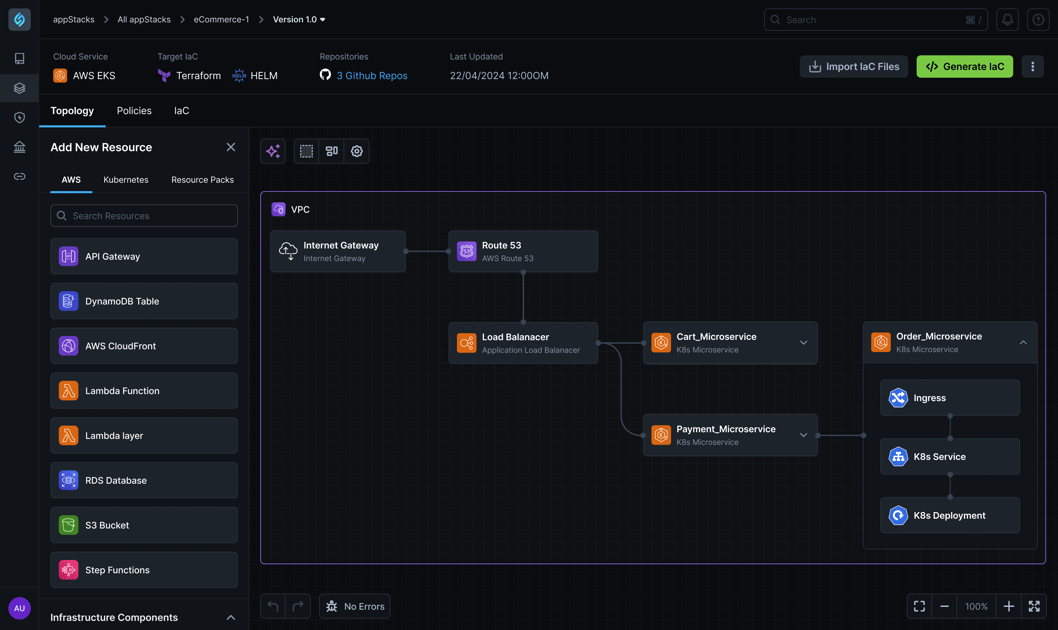PlatformCon25: Join StackGen at PlatformCon NY, the platform engineering event of the year. Register Now
The Ongoing Challenge of Infrastructure Modernization

Infrastructure modernization is a lot like perpetual road construction: just when you think the path is clear, you hit another stretch of cones, detours, and delays. It’s a process that never seems to end—whether it’s a major overhaul or incremental improvements, there’s always something being upgraded, updated, retired, or replaced.
For DevOps teams, this reality presents a frustrating paradox. The very infrastructure you’re trying to modernize is not only critical to day-to-day business operations but has often been running successfully for years. How do you make transformative updates without risking business continuity?
In this post, I’ll delve into why infrastructure modernization is inherently difficult, the obstacles DevOps teams face, and how tools like Infrastructure from Code (IfC) can ease the process and deliver long-term value.
The Problem: Why Infrastructure Modernization Feels Impossible
Organizations that rely on “outdated” cloud environments often struggle with a fragmented and inconsistent approach to managing infrastructure. Instead of being built on a cohesive strategy, these environments tend to rely on:
- Shell scripts and manual configurations.
- Console-based operations i.e. ClickOps.
- Inconsistent adoption of tools like Terraform (TF) or CloudFormation (CF).
This patchwork approach creates significant challenges:
- Opaque Systems: Many environments were created by individuals who have since left the organization, leaving behind undocumented or poorly understood systems. Without proper documentation, teams lack the visibility needed to make informed decisions.
- Uncertainty in Change Management: Even minor updates, like adding or removing resources, can have unforeseen impacts. Teams struggle to predict the “blast radius” of changes, leading to delays and potential disruptions.
- Policy Enforcement Gaps: In the absence of codified infrastructure, ensuring compliance with security policies, governance standards, or cost controls becomes nearly impossible.
As a result, organizations are left with brittle systems that can’t adapt to changing business needs, creating an ongoing cycle of inefficiency and risk.
Why It’s Hard: The Core Challenges of Modernization
Infrastructure modernization isn’t just a technical problem—it’s a multifaceted challenge that spans technology, operations, and organizational alignment. Here’s why it’s so difficult:
- Lack of Visibility
Without a clear and accurate picture of your current infrastructure, you’re flying blind.
- Hidden Dependencies: Legacy environments often have undocumented dependencies between systems, making it difficult to predict how changes will impact operations.
- Incomplete Audits: Internal audits are expensive and rarely provide the level of detail needed for a comprehensive modernization effort.
- Manual Processes Are Inefficient
Many legacy environments are built on ad hoc, manual processes that don’t scale.
- Time-Consuming Updates: Making changes requires significant time and effort, as each update must be handled individually.
- Error-Prone Methods: Manual processes increase the likelihood of mistakes, which can lead to outages, cost overruns, or security vulnerabilities.
- Collaboration Challenges Across Teams
Infrastructure modernization requires input and alignment across multiple teams—DevOps, security, and engineering.
- Misaligned Goals: Different teams often have conflicting priorities, making it hard to establish a unified approach.
- Knowledge Silos: Lack of shared understanding about infrastructure systems can lead to miscommunication and costly errors.
- Scalability and Reliability Risks
Legacy environments are fragile by design, making them hard to scale and maintain reliably.
- Scaling Limitations: Manual or inconsistent processes lack the standardization needed to replicate environments efficiently across regions or workloads.
- Disaster Recovery Challenges: Without codified infrastructure, recovering from outages or implementing business continuity plans becomes a daunting task.
DevOps leaders tasked with infrastructure modernization need ways to overcome these challenges without adding more complexity.
The Solution: Simplifying Modernization with Infrastructure from Code (IfC)
To address these challenges, organizations need tools that provide clarity, automation, and collaboration. Infrastructure from Code (IfC) offers a powerful approach, turning existing infrastructure configurations into actionable, visual plans. Here’s how tools like StackGen can help:
- Visualize Existing Infrastructure
StackGen automatically maps your infrastructure, giving you a clear picture of what you have and how systems interact. This visibility makes it easier to identify redundancies, gaps, and areas for improvement.
- Simplify Collaboration
With visual appStacks, teams can easily share, review, and collaborate on infrastructure plans. This reduces misunderstandings and ensures everyone is aligned.
- Build Reusable Components
Create reusable subsystems—like standardized templates for networking or storage—that can be applied across your organization, saving time and ensuring consistency.
- Automate Governance and Best Practices
StackGen incorporates standards and best practices into every configuration, reducing errors and ensuring compliance automatically.
- Plan for the Future with Confidence
By visualizing your infrastructure and integrating predictive analytics, you can provision resources that meet today’s needs while scaling efficiently for tomorrow’s demands.
Getting Started: A Smarter Path to Modernization
Modernizing your infrastructure doesn’t have to feel overwhelming. By leveraging tools that automate discovery, foster collaboration, and enforce best practices, you can turn a daunting process into a manageable—and even strategic—initiative.
Key Takeaways:
- Understand your starting point: Begin with an accurate map of your existing infrastructure.
- Eliminate inefficiencies: Identify and address redundancies to streamline operations.
- Future-proof your systems: Provision for current needs while planning for growth.
- Whatever tools or approaches you adopt, remember that every tool has assumptions baked in. Take the time to evaluate whether the tool aligns with your organization’s unique needs and goals.
With the right strategy and tools, you can transform your infrastructure into a competitive advantage.


